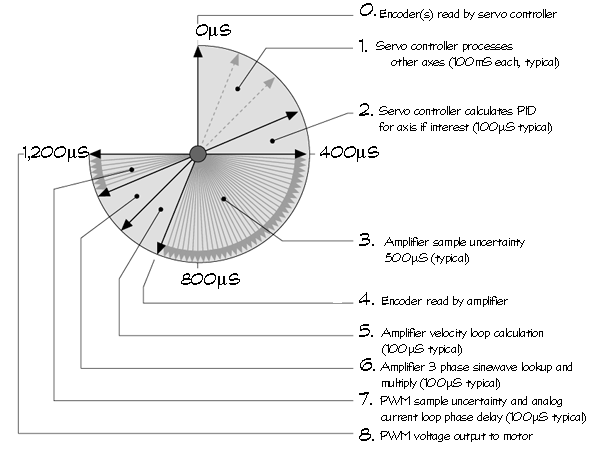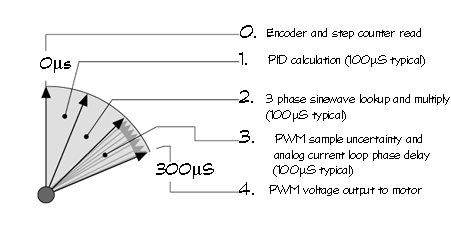 |
You have seen how quickly and accurately the SST produces torque
after it calculates the required amountóthis is the Torque Response Time.
Now letís examine the Total Servo Phase Delay-the total time from the
moment the position feedback is read to the time that torque begins to
be updated.
 Total Servo
Phase Delay (TSPD) is not only dependent upon the time it takes for each
individual step in the servo process to be completed, but it is also influenced
by the degree of synchronization of these steps. If elements of the system
operate asynchronously, as is the case with the traditional servo
architecture (where one or more servo loops are closed by the controller
and the remainder by the amplifier), this lack of synchronization will
cause uncertainties which, on average, will drastically increase the TSPD. Total Servo
Phase Delay (TSPD) is not only dependent upon the time it takes for each
individual step in the servo process to be completed, but it is also influenced
by the degree of synchronization of these steps. If elements of the system
operate asynchronously, as is the case with the traditional servo
architecture (where one or more servo loops are closed by the controller
and the remainder by the amplifier), this lack of synchronization will
cause uncertainties which, on average, will drastically increase the TSPD.
 WorldServo chose
a step and direction input architecture not only for noise immunity and
as a convenience for upgrading from stepper motor systems, but because
this allowed us to close all the servo loops with one processor. This
eliminated all of the delays and uncertainties associated with the asynchronism
of the traditional architecture. This is a big advantage of any skillfully
implemented step and direction servo. WorldServo chose
a step and direction input architecture not only for noise immunity and
as a convenience for upgrading from stepper motor systems, but because
this allowed us to close all the servo loops with one processor. This
eliminated all of the delays and uncertainties associated with the asynchronism
of the traditional architecture. This is a big advantage of any skillfully
implemented step and direction servo.
 WorldServo went
several steps further to reduce TSPD. We dedicated a DSP to each axis,
designed a true digital torque controller and developed proprietary algorithms
optimized specifically for reducing TSPD. The result of these efforts
can be seen in the figures below. Low TSPD, combined with improved Torque
Response Time, strengthens the weak links found in other servos and results
in state-of-the-art servo bandwidth. WorldServo went
several steps further to reduce TSPD. We dedicated a DSP to each axis,
designed a true digital torque controller and developed proprietary algorithms
optimized specifically for reducing TSPD. The result of these efforts
can be seen in the figures below. Low TSPD, combined with improved Torque
Response Time, strengthens the weak links found in other servos and results
in state-of-the-art servo bandwidth.
|




